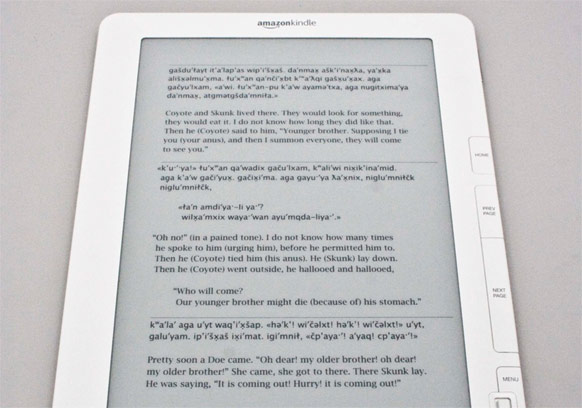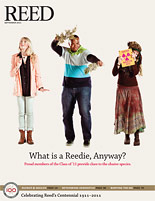
IRIS login | Reed College home Volume 90, No. 3: September 2011
Thinking Reed: Centennial Essays
Rescued from a Life of Crime (continued)

Holmes & Bigelow adapted their font Lucida Sans to display digital typography for Kiksht, a native language of the Pacific Northwest.
Despite the virtues of literacy we all enjoy, the dark side of literacy has long been its association with the domination of some social groups by others (as observed by the French ethnologist Claude Lévi-Strauss, whom I read at Reed). Within a society, literates tend to be wealthier and more powerful than illiterates, while between societies, the more literate have often dominated the less. Hence, can changes in literacy cause changes in allocation of power?
In eighteenth-century England, the literacy rate was roughly 50 percent or less for men and 25 percent or less for women (data vary by location, time period, and social class). In the nineteenth century, during the Industrial Revolution, England promulgated universal education to compete against rival nations, and the resultant increase in literacy eventually caused a shift in power within English society. By 1900, literacy rates had risen above 90 percent for both men and women, and a consequence of the nearly fourfold increase in literacy for women was political agitation for women’s suffrage: having achieved literacy on a par with men, women demanded, and eventually won, parity in voting rights. That leads to another question: do increases in authorship rates cause social changes?
The vision scientist Denis Pelli and I studied the rate of increase in authorship since the invention of printing. Within a century there were major social, cultural, religious, and economic upheavals, including the Renaissance, the Reformation, mercantilism, and European imperialism. It seems reasonable to surmise that printing, by vastly increasing the capacity of information channels, ignited or spurred these historical developments. In reaction, official censorship was established, often wielding the death penalty. That seems medieval, but of course it is still going on today in some countries.
Pelli and I observed that the number of authors of books published each year in Europe and America increased nearly tenfold every century until the twenty-first century. But when we looked at the most recent decade of electronic media, including blogging, Facebook, Myspace, Twitter, and YouTube, we found that the rate of authorship (depending on how one defines “author”) had increased tenfold each year. This huge increase in authors has been associated with social disruptions and conflicts, including political protests over elections in Iran; legal disputes over copyright, privacy rights, and cyber-bullying; international security concerns over publication of secret documents by WikiLeaks; and reactionary imposition of electronic censorship in several countries.
It seems to me that societies can absorb gradual increases of information exchange without threat to established social institutions, but when societies acquire or adopt new technologies that transmit far more information than the channel capacity of established institutions, severe disruptions follow.
I like to think that our Lucida type designs helped solve a few technical and aesthetic problems in a time of transition in the technology of literacy, and that our pioneering efforts encouraged others to make further explorations, but we were only part of a bigger trend. Advances in digital typography over the past three decades laid the foundation for textual information exchange on a grander scale than previously imagined. Social networking, text messaging, book digitization, e-book proliferation, spam email, wikis—all are based on vastly easier and speedier modes of text creation, transmission, and rendering.
My remarks may make it seem as if my Reed interests and later studies invariably led to substantial achievements, but that’s far from the truth. Although I have told of a few investigations and undertakings that turned out to have practical applications, I have left out many more that remain unfinished despite years of work and others that led nearly nowhere.
Despite my mentions of the Odyssey, my happiest time at Reed was spent reading myths that came not from ancient Greece, but from West Linn, Oregon, just south of Portland. In 1929–30, near the Willamette River, an elderly Native American woman, Victoria Howard, told a fabulous set of stories in her native language, Clackamas Chinook (or Kiksht, as she called it), to a young anthropologist named Melville Jacobs.
Howard told of a lost world, often comic, often tragic, and often just plain strange, not fitting into the Greek, Roman, or European canons of thought. Coyote trades assholes with Skunk and gets into trouble. A cross-dressing wife murders her husband without explanation; the blood drips onto his daughter sleeping on the bunk below. Coyote goes on his own odyssey up the Columbia River, grapples with monstrosities, gets into trouble with girls, but eventually makes things right for the Indians who will soon come to the land. A young woman wishes on a star and finds a young man in bed with her the next morning.
Howard also narrated heartbreaking oral histories of the coming of white men (whom the Clackamas called “Bostons”) and the plagues that wiped out most of her people; how they died; how soldiers forced the survivors into concentration camps, where the old people wept.
Howard was probably Oregon’s finest narrator. Her stories are as enchanting and gripping as ancient Greek myths but earthier, unsmoothed by centuries of literary refinement, and more compelling and unsettling for their roughness. They are marvels of linguistic and narrative subtlety that no one will ever again appreciate fully, since her language is lost. Yet, despite her greatness, she remains nearly unknown, an obscure old woman who spoke instead of wrote in a nearly incomprehensible, dying language in a culture destroyed by invading Euro-Americans. The same thing could have happened to our classical literature. Had the mighty Persian empire beaten the Greeks at Marathon, Salamis, and Plataea, the stories of Homer might today be only obscure footnotes to the mythography of minor tribes, and the dramas of Aeschylus, Sophocles, and Euripides never written or known at all.
Tradition tells us that Homer, if he existed, was blind, so we may surmise that a scribe skilled in the new technology of the alphabet wrote down the Homeric epics as the bard dictated them. So it was with Howard and Jacobs: a gifted woman with an astonishing memory, telling the stories of her lost culture one last time, entrancing a dapper young New Yorker to write it all down in his field notebooks in a special phonetic alphabet. Howard died soon thereafter, and Jacobs spent the next quarter century editing, transcribing, and typing the texts until he published them in the late fifties.
I still read and marvel at these stories, in both English and Kiksht. Four decades after I first read them at Reed, they still fill me with an unquenchable sense of loss: for Mrs. Howard, who died unrecognized before I was born but whose spirit animates the stories; for Jacobs, whom I knew and admired for his indefatigable efforts to salvage the extant remnants of native literary cultures; for David French, who astutely recommended I study these texts at Reed; and for the late Dell Hymes ’50, eminent linguistic anthropologist who generously helped me study and work on the texts for a project, still unfinished, to publish them in a new edition. I have to admit that, contrary to my youthful enthusiasm at Reed, I will never understand more than a fraction of the richness of these stories.
- Previous Page
- 1
- 2
- 3
- Next Page


LATEST COMMENTS
steve-jobs-1976 I knew Steve Jobs when he was on the second floor of Quincy. (Fall...
Utnapishtim - 2 weeks ago
Prof. Mason Drukman [political science 1964–70] This is gold, pure gold. God bless, Prof. Drukman.
puredog - 1 month ago
virginia-davis-1965 Such a good friend & compatriot in the day of Satyricon...
czarchasm - 4 months ago
John Peara Baba 1990 John died of a broken heart from losing his mom and then his...
kodachrome - 7 months ago
Carol Sawyer 1962 Who wrote this obit? I'm writing something about Carol Sawyer...
MsLaurie Pepper - 8 months ago
William W. Wissman MAT 1969 ...and THREE sisters. Sabra, the oldest, Mary, the middle, and...
riclf - 10 months ago